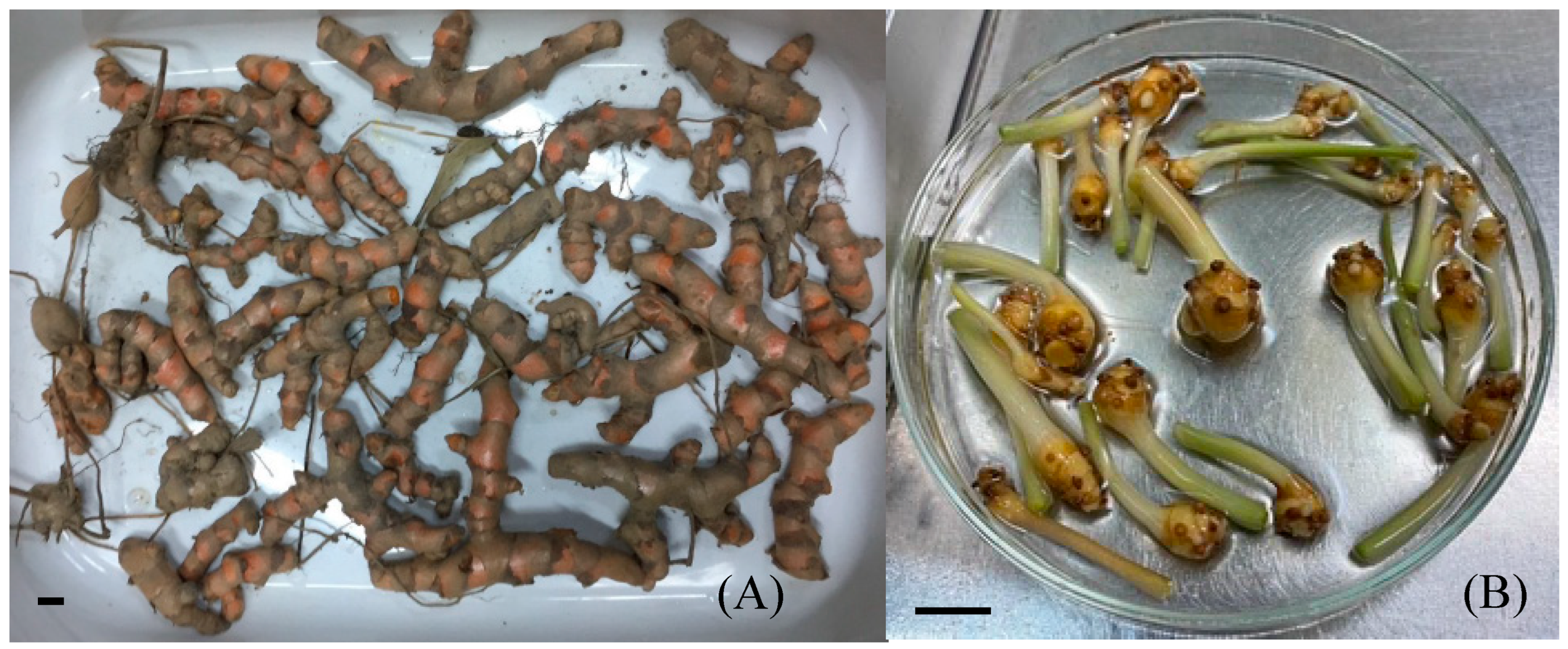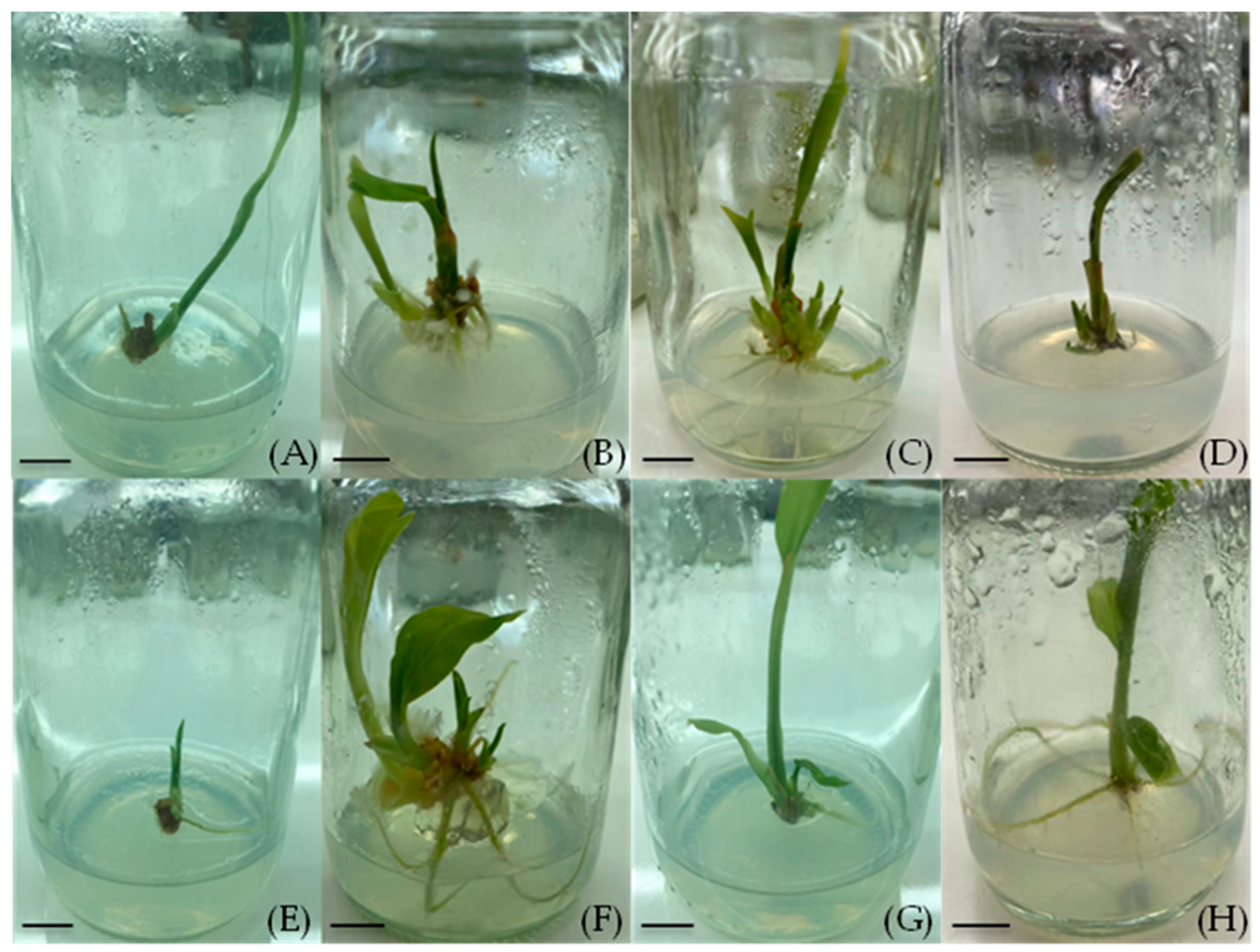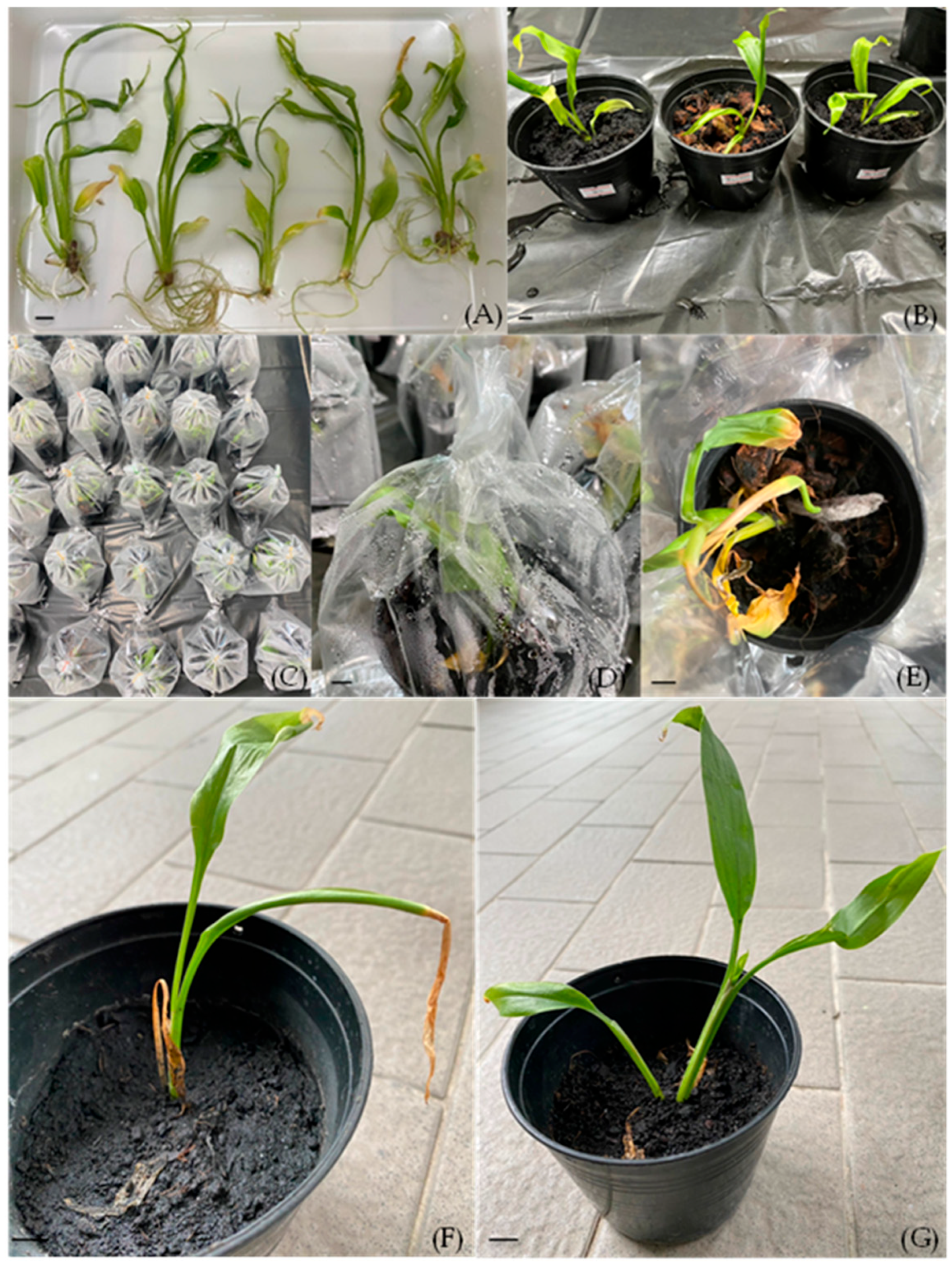Development of an Efficient Micropropagation Protocol for Curcuma longa L. cv. Trang 1
Abstract
1. Introduction
2. Materials and Methods
2.1. Plant Materials
2.2. Explant Sterilization
2.3. Shoot Induction
2.4. Root Induction
2.5. Acclimatization and Transplantation
2.6. Data Analysis
3. Results
3.1. Effects of BA and NAA on Shoot Induction
3.2. Effects of TDZ and BA on Shoot Induction
3.3. Effect of mT on Shoot Induction
3.4. Root Induction
3.5. Transplantation
4. Discussion
5. Conclusions
Author Contributions
Funding
Data Availability Statement
Acknowledgments
Conflicts of Interest
References
- Li, S.; Yuan, W.; Deng, G.; Wang, P.; Yang, P.; Aggarwal, B.B. Chemical composition and product quality control of turmeric (Curcuma longa L.). Pharm. Crop. 2011, 5, 28–54. [Google Scholar] [CrossRef]
- Razavi, B.M.; Ghasemzadeh Rahbardar, M.; Hosseinzadeh, H. A review of therapeutic potentials of turmeric (Curcuma longa) and its active constituent, curcumin, on inflammatory disorders and pain, and their related patents. Phytother. Res. 2021, 35, 6489–6513. [Google Scholar] [CrossRef] [PubMed]
- Sivakumar, P.; Monisha, S.; Selvaraj, K.V.; Chitra, M.; Prabha, T.; Santhakumar, M.; Bharathi, A.; Velayutham, A. Nutritional value, phytochemistry, pharmacological and in vitro regeneration of turmeric (Curcuma longa L.): An updated review. Ann. Phytomed. 2022, 11, 236–246. [Google Scholar] [CrossRef]
- Salvi, N.D.; George, L.; Eapen, S. Micropropagation and field evaluation of micropropagated plants of turmeric. Plant Cell Tissue Organ Cult. 2002, 68, 143–151. [Google Scholar] [CrossRef]
- Kambaska, K.B.; Santilata, S. Effect of plant growth regulators on micropropagation of ginger (Zingiber officinale Rosc.) cvs. Suprava and Suruchi. J. Agric. Technol. 2009, 5, 271–280. [Google Scholar]
- Hagos, R.; Gebremdhin, H. Effects of cytokinin types and their concentration on in vitro shoot induction and multiplication of korarima (Aframomum corrorima). Int. J. Genet. Mol. Biol. 2015, 7, 8–14. [Google Scholar]
- Di, D.W.; Zhang, C.; Luo, P.; An, C.W.; Guo, G.Q. The biosynthesis of auxin: How many paths truly lead to IAA? Plant Growth Regul. 2016, 78, 275–285. [Google Scholar] [CrossRef]
- Lee, K.; Yoon, H.; Park, O.S.; Seo, P.J. A positive feedback loop of cytokinin signaling ensures efficient de novo shoot regeneration in Arabidopsis. New Phytol. 2025, 246, 18–27. [Google Scholar] [CrossRef]
- Astutik, M.; Suhartanto, B.; Umami, N.; Suseno, N.; Haq, M.S. Auxin and cytokinin effect on in vitro callus induction of maize (Zea mays L.) Srikandi Putih. In Proceedings of the 6th International Seminar of Animal Nutrition and Feed Science (ISANFS 2021), Yogyakarta, Indonesia, 7–8 July 2021; Atlantis Press: Dordrecht, The Netherlands, 2022; pp. 1–5. [Google Scholar]
- Chakraborty, A.; Santra, I.; Haque, S.M.; Ghosh, B. In vitro conservation of commercial and threatened members of Zingiberaceae: An Indian scenario. Biodivers. Conserv. 2023, 32, 2155–2195. [Google Scholar] [CrossRef]
- Murashige, T.; Skoog, F. A revised medium for rapid growth and bioassays with tobacco tissue cultures. Physiol. Plant. 1962, 15, 473–497. [Google Scholar] [CrossRef]
- R Core Team R. A Language and Environment for Statistical Computing; R Foundation for Statistical Computing: Vienna, Austria, 2024; Available online: https://www.R-project.org/ (accessed on 21 April 2025).
- Shapiro, S.S.; Wilk, M.B. An analysis of variance test for normality (complete samples). Biometrika 1965, 52, 591–611. [Google Scholar] [CrossRef]
- Kruskal, W.H.; Wallis, W.A. Use of ranks in one-criterion variance analysis. J. Am. Stat. Assoc. 1952, 47, 583–621. [Google Scholar] [CrossRef]
- Holm, S. A simple sequentially rejective multiple test procedure. Scand. J. Stat. 1979, 6, 65–70. [Google Scholar]
- Raihana, R.; Faridah, Q.Z.; Julia, A.A.; Abdelmageed, A.H.A.; Kadir, M. In vitro culture of Curcuma mangga from rhizome bud. J. Med. Plant Res. 2011, 5, 6418–6422. [Google Scholar] [CrossRef]
- Jala, A. Effects of NAA, BA and sucrose on shoot induction and rapid micropropagation by trimming shoot of Curcuma longa L. Thammasat Int. J. Sci. Technol. 2012, 17, 54–60. [Google Scholar]
- Rahman, M.; Amin, M.; Jahan, H.; Ahmed, R. In vitro regeneration of plantlets of Curcuma longa Linn.: A valuable spice plant in Bangladesh. Asian J. Plant Sci. 2004, 3, 306–309. [Google Scholar] [CrossRef]
- Yorgancılar, M.; Erişen, S. The effect of thidiazuron (TDZ) on shoot regeneration of Astragalus schizopterus. J. Anim. Plant Sci. 2011, 21, 519–524. [Google Scholar]
- Verma, M.; Bansal, Y.K. Effect of a potent cytokinin thidiazuron (TDZ) on in vitro regeneration of Hedychium coronarium J. Koenig, a valuable medicinal plant. Int. J. Rec. Biotechnol. 2014, 2, 38–44. [Google Scholar]
- Khalafalla, M.M.; Hattori, K. A combination of thidiazuron and benzyladenine promotes multiple shoot production from cotyledonary node explants of faba bean (Vicia faba L.). Plant Growth Regul. 1999, 27, 145–148. [Google Scholar] [CrossRef]
- Gentile, A.; Jaquez Gutiérrez, M.; Martinez, J.; Frattarelli, A.; Nota, P.; Caboni, E. Effect of meta-topolin on micropropagation and adventitious shoot regeneration in Prunus rootstocks. Plant Cell Tissue Organ Cult. 2014, 118, 373–381. [Google Scholar] [CrossRef]
- Werbrouck, S.P.; Strnad, M.; Van Onckelen, H.A.; Debergh, P.C. Meta-topolin, an alternative to benzyladenine in tissue culture? Physiol. Plant. 1996, 98, 291–297. [Google Scholar] [CrossRef]
- Behera, S.; Barik, D.P.; Naik, S.K. In vitro propagation and genetic fidelity assessment of Hedychium coronarium J. Koenig regenerated from axenic cotyledonary nodes on meta-topolin-supplemented medium. Ind. Crops Prod. 2019, 134, 206–215. [Google Scholar] [CrossRef]
- Waman, A.A.; Bohra, P.; Karthika Devi, R.; Pixy, J. In vitro multiplication protocol for Curcuma mangga: Studies on carbon, cytokinin source and explant size. J. Hortic. Sci. 2021, 16, 69–76. [Google Scholar] [CrossRef]
- Elayaraja, D.; Subramanyam, K.; Vasudevan, V.; Sathish, S.; Kasthurirengan, S.; Ganapathi, A.; Manickavasagam, M. Meta-topolin (mT) enhances the in vitro regeneration frequency of Sesamum indicum L. Biocatal. Agric. Biotechnol. 2019, 21, 101320. [Google Scholar]
- Wojtania, A. Effect of meta-topolin on in vitro propagation of Pelargonium × hortorum and Pelargonium × hederaefolium cultivars. Acta Soc. Bot. Pol. 2010, 79, 101–106. [Google Scholar] [CrossRef]
- Bairu, M.W.; Stirk, W.A.; Doležal, K.; Van Staden, J. Optimizing the micropropagation protocol for the endangered Aloe polyphylla: Can meta-topolin and its derivatives serve as replacements for benzyladenine and zeatin? Plant Cell Tissue Organ. Cult. 2007, 90, 15–23. [Google Scholar] [CrossRef]
- Tien, L.X.; Chac, L.X.; Oanh, L.T.; Ly, P.T.; Sau, H.V.; Hung, N.H.; Thanh, V.D.; Doudkin, R.; Thinh, B.D. Effect of auxins (IAA, IBA and NAA) on clonal propagation of Solanum procumbens stem cuttings. Plant Cell Biotechnol. Mol. Biol. 2020, 21, 113–120. [Google Scholar]
- Al-Saqri, F.; Alderson, P. Effects of IBA, cutting type and rooting media on the rooting of Rosa centifolia cuttings. J. Hortic. Sci. 1996, 71, 729–737. [Google Scholar] [CrossRef]
- Jualang, A.G.; Nurul Humairah, T.A.; Devina, D.; Hartinie, M. In vitro shoot regeneration from rhizome bud of native ginger in Borneo, Etlingera coccinea. J. Trop. Plant Physiol. 2015, 7, 36–46. [Google Scholar]
- Haque, S.M.; Ghosh, B. Micropropagation of Kaempferia angustifolia Roscoe—An aromatic, essential oil yielding, underutilized medicinal plant of Zingiberaceae. J. Crop Sci. Biotechnol. 2018, 21, 147–153. [Google Scholar] [CrossRef]
- Alqadasi, A.S.; Al-Madhagi, I.; Al-Kershy, A.; Al-Samaei, M. Effect of cytokinin type and pH level on regeneration of ginger in vitro. Int. J. Hortic. Sci. Technol. 2022, 9, 293–302. [Google Scholar]
- Faridah, Q.Z.; Abdelmageed, A.; Julia, A.A.; Hafizah, R.N. Efficient in vitro regeneration of Zingiber zerumbet Smith (a valuable medicinal plant) from rhizome bud explants. Afr. J. Biotechnol. 2011, 10, 9303–9308. [Google Scholar] [CrossRef]
- Yunus, M.F.; Abd Aziz, M.; Kadir, M.A.; Rashid, A.A. In vitro propagation of Etlingera elatior (Jack) (torch ginger). Sci. Hortic. 2012, 135, 145–150. [Google Scholar] [CrossRef]





| NAA (mg/L) | BA (mg/L) | Shoot Induction (%) | Number of Shoots | Shoot Height (cm) |
|---|---|---|---|---|
| 0 | 0 | 0.00 ± 0.00 | 0.00 ± 0.00 b | 0.00 ± 0.00 |
| 0 | 1.0 | 50.00 ± 28.87 | 1.00 ± 0.58 b | 1.10 ± 0.65 |
| 0 | 3.0 | 100.00 ± 0.00 | 4.60 ± 1.47 a | 2.34 ± 0.61 |
| 0 | 5.0 | 75.00 ± 25.00 | 1.50 ± 0.65 b | 1.01 ± 0.53 |
| 1.0 | 0 | 50.00 ± 28.87 | 0.50 ± 0.29 b | 0.65 ± 0.45 |
| 1.0 | 1.0 | 75.00 ± 25.00 | 1.00 ± 0.41 b | 1.09 ± 0.66 |
| 1.0 | 3.0 | 33.33 ± 33.33 | 0.67 ± 0.67 b | 0.45 ± 0.45 |
| 1.0 | 5.0 | 25.00 ± 25.00 | 0.25 ± 0.25 b | 0.58 ± 0.58 |
| Kruskal–Wallis test | NS | <0.05 * | NS | |
| BA (mg/L) | TDZ (mg/L) | Shoot Induction (%) | Number of Shoots | Shoot Height (cm) |
|---|---|---|---|---|
| 0 | 0 | 37.50 ± 18.30 b | 1.00 ± 0.57 b | 0.57 ± 0.37 b |
| 0 | 0.5 | 100.00 ± 0.00 a | 5.22 ± 0.64 a | 1.48 ± 0.23 ab |
| 0 | 1.0 | 100.00 ± 0.00 a | 4.50 ± 0.53 a | 0.96 ± 0.13 ab |
| 3.0 | 0 | 100.00 ± 0.00 a | 3.44 ± 0.47 ab | 1.53 ± 0.17 a |
| 3.0 | 0.5 | 100.00 ± 0.00 a | 3.78 ± 0.70 a | 1.52 ± 0.21 a |
| 3.0 | 1.0 | 100.00 ± 0.00 a | 4.56 ± 0.56 a | 1.21 ± 0.13 ab |
| Kruskal–Wallis test | <0.001 * | <0.005 * | <0.05 * | |
| mT (mg/L) | Shoot Induction (%) | Number of Shoots | Shoot Height (cm) |
|---|---|---|---|
| 0.0 | 100 ± 0.00 | 2.27 ± 0.38 b | 5.69 ± 0.79 a |
| 0.5 | 100 ± 0.00 | 4.20 ± 0.25 a | 3.05 ± 0.29 b |
| 1.0 | 100 ± 0.00 | 5.00 ± 0.85 a | 3.76 ± 0.59 b |
| 1.5 | 100 ± 0.00 | 5.86 ± 0.67 a | 2.77 ± 0.24 b |
| 2.0 | 100 ± 0.00 | 5.57 ± 0.61 a | 2.34 ± 0.29 b |
| Kruskal–Wallis test | NS | <0.001 * | <0.005 * |
| IBA (mg/L) | NAA (mg/L) | Root Induction (%) | Number of Roots | Root Lengths (cm) |
|---|---|---|---|---|
| - | - | 100.00 ± 0.00 a | 6.69 ± 0.57 a | 3.01 ± 0.31 b |
| 1.0 | - | 100.00 ± 0.00 a | 4.40 ± 0.58 b | 4.13 ± 0.36 a |
| 2.0 | - | 100.00 ± 0.00 a | 7.33 ± 1.49 a | 3.70 ± 0.46 ab |
| - | 1.0 | 37.5 ± 12.50 b | 0.50 ± 0.18 c | 0.09 ± 0.03 c |
| - | 2.0 | 28.57 ± 12.53 b | 0.36 ± 0.17 c | 0.11 ± 0.05 c |
| Kruskal–Wallis test | <0.001 * | <0.001 * | <0.001 * | |
Disclaimer/Publisher’s Note: The statements, opinions and data contained in all publications are solely those of the individual author(s) and contributor(s) and not of MDPI and/or the editor(s). MDPI and/or the editor(s) disclaim responsibility for any injury to people or property resulting from any ideas, methods, instructions or products referred to in the content. |
© 2025 by the authors. Licensee MDPI, Basel, Switzerland. This article is an open access article distributed under the terms and conditions of the Creative Commons Attribution (CC BY) license (https://creativecommons.org/licenses/by/4.0/).
Share and Cite
Boonprasert, A.; Chitphet, P.; Sanevas, N.; Kraichak, E.; Vuttipongchaikij, S.; Wongkantrakorn, N. Development of an Efficient Micropropagation Protocol for Curcuma longa L. cv. Trang 1. Int. J. Plant Biol. 2025, 16, 64. https://doi.org/10.3390/ijpb16020064
Boonprasert A, Chitphet P, Sanevas N, Kraichak E, Vuttipongchaikij S, Wongkantrakorn N. Development of an Efficient Micropropagation Protocol for Curcuma longa L. cv. Trang 1. International Journal of Plant Biology. 2025; 16(2):64. https://doi.org/10.3390/ijpb16020064
Chicago/Turabian StyleBoonprasert, Atcha, Pundanai Chitphet, Nuttha Sanevas, Ekaphan Kraichak, Supachai Vuttipongchaikij, and Narong Wongkantrakorn. 2025. "Development of an Efficient Micropropagation Protocol for Curcuma longa L. cv. Trang 1" International Journal of Plant Biology 16, no. 2: 64. https://doi.org/10.3390/ijpb16020064
APA StyleBoonprasert, A., Chitphet, P., Sanevas, N., Kraichak, E., Vuttipongchaikij, S., & Wongkantrakorn, N. (2025). Development of an Efficient Micropropagation Protocol for Curcuma longa L. cv. Trang 1. International Journal of Plant Biology, 16(2), 64. https://doi.org/10.3390/ijpb16020064






